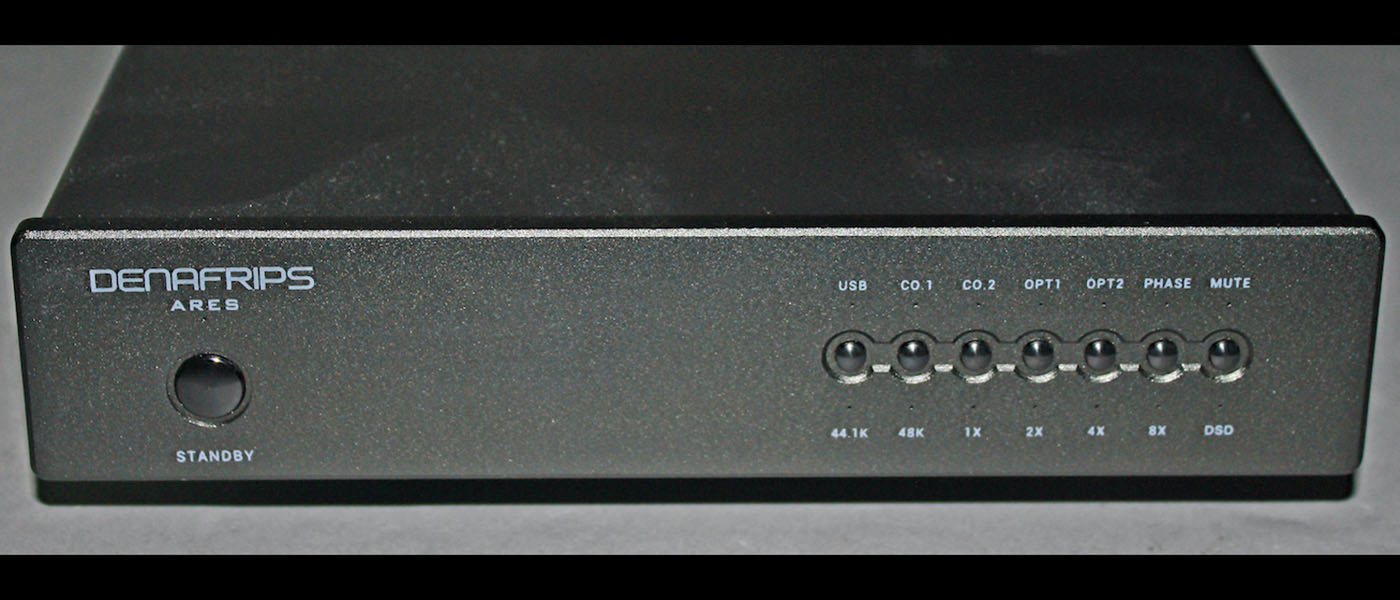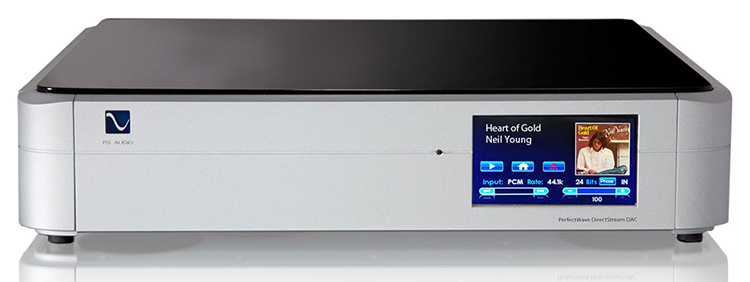
I first knew of PS Audio when they were best-known for amplifiers which they, of course, still design and produce. They also make preamplifiers, power conditioners, an integrated amp the size of a Jane Austen novel, audio accessories, and a unique DSD DAC that I am reviewing here today, the PerfectWave DirectStream DAC.
PS Audio PerfectWave DirectStream DAC
- FPGA (field-programmable gate array) core processor chip
- Digital input is up-sampled to 20 times standard DSD rate (2.84MHz) before processing
- Post-processing signal is converted to double-rate DSD (5.6MHz) then to passively filtered analog output
- Handwritten FPGA code by Ted Smith, voiced by Paul McGowan and the late Arnie Nudell
- The FPGA code has been tweaked several times and those upgrades are FREE
- Resolution perfect volume and balance controls built-in
- Simple, direct signal path with one master clock which is immune to incoming jitter
Input Power:
Model specific 100VAC, 120VAC, or 230VAC 50 or 60Hz
Power Consumption:
30W
Digital audio inputs:
I2S(2), Coax, XLR Balanced, TOSLINK, USB, Network Bridge slot
Sample Rates:
I2S, and USB — 44.1kHz to 352.8kHz 16bit, 24bit, DSD 64, DSD 128
TOSLINK – 44.1kHz to 96kHz 16bit, 24bit
XLR (AES/EBU) S/PDIF (coax)– 44.1kHz to 192kHz 16bit, 24bit, DSD 64
Connector:
RCA/XLR Unbalanced /Balanced (x2
Output level, low
0.282VRMS, Balanced 0.141VRMS Single Ended
Output level high
maximum: 2.818VRMS Balanced, 1.414VRMS Single Ended
Frequency Response:
20-20kHz +/- 0.25dB, THD&IM @ 1kHz (full scale) <0.03%
Output Stage:
Passive audio transformer, fed by high current, high-speed analog amps producing double rate DSD
Format:
PCM or DSD
Sample rate (PCM):
44.1kHz, 48kHz, 88.2kHz, 96kHz, 176.4kHz, 192kHz, 352.8kHz
Word length (PCM):
16-bit, 18-bit, 20-bit, 24-bit
Data rate (DSD):
Standard (2.8MHz) or Double (5.6MHz) DoP as well as raw DSD on I2S and USB inputs
Input jitter reduction:
effectively 100%, residual immeasurable. No input PLLs or FLLs
Input Processing:
170MHz
Signal Processing:
50MHz
Synchronous Upsampling, all inputs:
28.224MHz
Digital Processing S/N ratio:
>146dB
Digital Volume Control with zero loss of precision
Analog Conversion method:
Delta Sigma (DSD) Single-bit double rate
Format:
PCM or DSD. DoP on all inputs as well as raw DSD on I2S inputs
USB Digital Input:
USB B-type
Format:
PCM or DoP v1.1 (DSD over PCM)
Transfer mode:
Asynchronous
Unit Weight:
22lbs [9.97kg]
Unit Dimensions:
14” x 17” x 4” [36cm x 43cm x 10cm]
Shipping Weight:
31lbs [14kg]
MSRP:
$5999- $6899 (with Bridge II)
Company:
SECRETS Tags:
PS Audio, DirectStream DAC, DAC, DSD, DAC Review 2019
- Auralic VEGA G2 DAC and LEO GX Master Clock Review
- HIFIMAN R2R2000 HD Streaming Audio Device and DAC
Recently I was reviewing a product that really upped the ante for sound quality and it made me realize that I was missing that chemistry I used to have for my music. I had chalked up the lifeless sound of my system to the new, larger room I had moved into, but now I realize that it was more likely tied to my long-in-the-tooth DAC. I noticed sonic improvement with the time I spent recently with a powerful Class-D amplifier that really added punch and body to my system. That sonic life really improved with the last digital preamplifier I reviewed earlier this summer and I attributed that improvement (amongst other things) to the DAC. The sound had more dimensional energy, impact, and just sounded more alive. I was loving my music collection again! That experience got me into pursuing better quality DACs in my continuing quest to reach that mythical sonic Nirvana.

Enter the PS Audio PerfectWave DirectStream DAC, which is a state-of-the-art-DSD digital-to-analog converter, preamplifier, and media center designed into a large, slick-looking aluminum and polished blackwood designed product with no discernable knobs or buttons on the faceplate. Inside the carton were a pair of white gloves, power cable, aluminum-faced backlit remote control, a PS Audio catalog, and a very interesting, in-depth owner’s manual. There were also a few PS Audio decals that reminded me of the ones I got when I bought my MAC mini. The really unique aspect of the PS Audio DSD (DirectStream DAC) is that the core processor is not an off-the-shelf DAC chip from Burr-Brown, Wolfson, or Sabre, but a field-programmable gate array (FPGA). This chip is used in many different electronic devices. As a nuclear medicine technologist, I know there are some inside the gamma camera that I use every day at the hospital. I think of this chip less like hardware but more like a programmable software-type device. Audio researcher and consultant Ted Smith is the guy who has handwritten the programmed architecture of the FPGA from the digital inputs to the passive output stages. This design offers the listener extremely low jitter as it uses one master clock for all incoming signals. The incoming digital data can be in PCM or DSD format which is then upconverted to 20 times the DSD sample rate prior to processing. Single rate DSD is DSD64. That means 64 times the sample rate of a CD (64 x 44.1kHz). DSD256 would be four times that (4 x 64 x 44.1kHz). With me so far? That means the PS Audio DSD is upsampling the incoming PCM to 20 times the nominal DSD rate (20 x 64 x 44.1kHz) which is 56.488MHz (as in million). After processing, the signal is down-converted to double DSD, sent through a passive low pass filter and out as an analog signal. I’m not going to get into the DSD being one bit at very high sample rates, because that has been covered by SECRETS in the past. In any case, why go to all this trouble? PS Audio is trying to extract musical information that can be masked by off-the-shelf PCM DAC chips. Interestingly, many of today’s PCM chips use sigma-delta modulation to get a DSD-like signal before analog conversion. Going the DirectStream route, the signal goes PCM>DSD>analog. The higher sample rate does not create new information from the original signal but allows for better filtering algorithms which allow for more of the detail of the original signal to come through. Noise is pushed into the higher frequency band and filtered out via a passive low pass filter. This brings out more details and improves imaging. The output DSD signal is fed directly into a stage based on high-speed video amplifiers (capable of handling the 5.6MHz signal) and a passive output transformer.
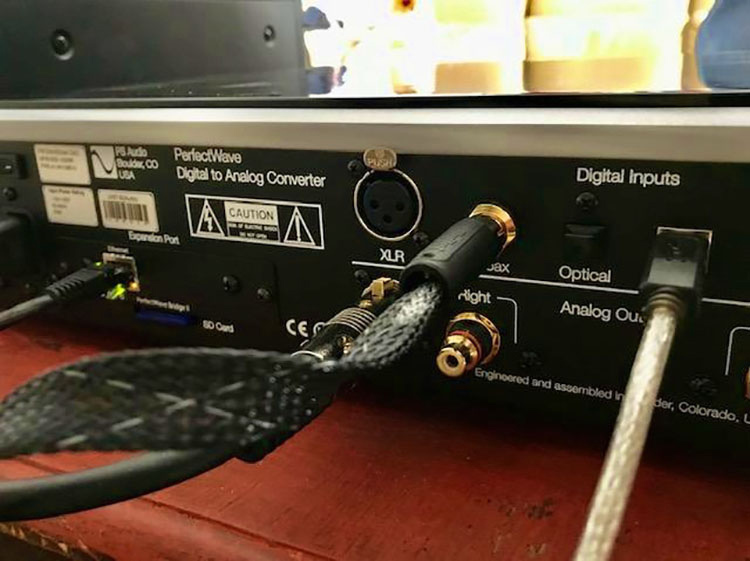
The PS Audio DSD has seven digital inputs; two I2S (pronounced eye squared S), and one each of TOSlink, coaxial, USB, AES/EBU, and a network input for the Bridge II module (which costs extra but came installed on my unit). Outputs are either balanced XLR or unbalanced RCA. The DirectStream is a fully balanced design.
The front of the unit has no buttons or knobs. Functionality is controlled by a well-designed remote or via the 4 x 2-inch touch screen panel. A master switch on the back places the DSD into ready mode. The blue logo light on the front left side of the panel lights up and serves as the on/off switch. The unit will initialize for about 30 seconds while it loads the current software into the FPGA via an SD card in the back. For album covers to display on the panel, you’ll need to leave the data card in place in the back, which is fine, that way you don’t lose it. Album art is only displayed via the network bridge.

Using the front panel touchscreen is intuitive; allowing you to select inputs and change the volume (which can also be set to Fixed). The panel displays the incoming input signal, sample rate, and bit depth. A unique feature is the ability to flip the phase of the incoming signal either from the panel of from the comfort of your couch via the remote. A timeline also lets you know how much track time has expired as you listen to your music. I do wish the timeline was another color than light blue, as it is hard to see on a blue background from my seating position. All inputs can be renamed.
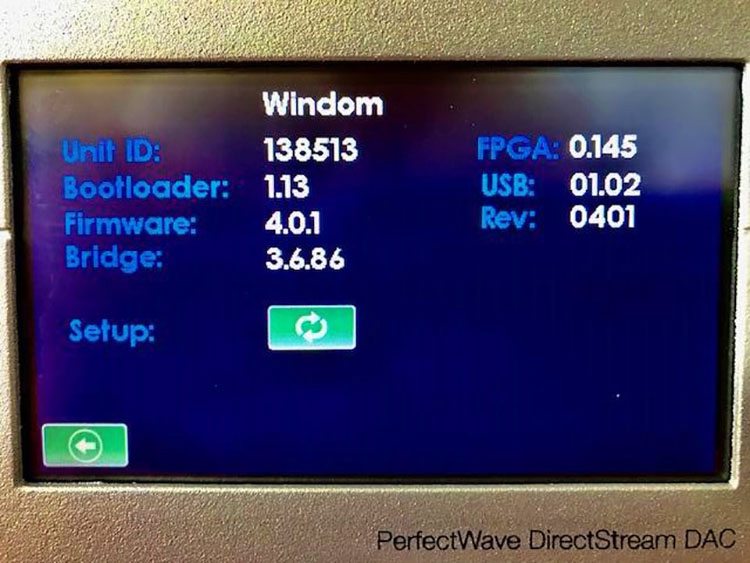
When new firmware is ready, you can go to PS Audio’s website and download it onto the provided SD card. These updates are named after mountain peaks in the Boulder area. I started out with Snowmass and got to experience the new update called Windom. The process was easy, and I had no loading issues during the 10-minutes it took. I’ll talk about my sonic impressions of Snowmass vs. Windom later in my review. This is what really makes the DirectStream DAC so unique. These tweaks and upgrades are FREE to owners. There have been several of these offered since the DirectStream’s inception, some five years ago. That means you get to try a “new DAC” every so often. What other DAC can do that? …and did I mention it’s FREE? Try getting a free Dirac upgrade. Now, if you have a few SD cards on hand, and you are really geeky into this, you could load a software from a previous release and re-load it for comparison and keep the one that you feel sounds the best on your system. The possibilities are endless (hyperbole, yes).
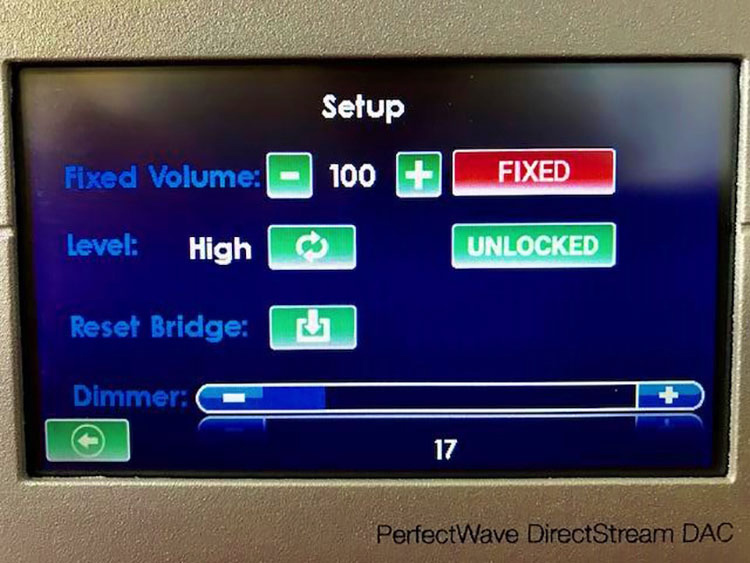
There is a lot of technical information on PS Audio’s website and the user manual has a lot of detailed information as well. I actually enjoyed reading the manual and found it interesting, even though I can be a Luddite at times. As complex as the DirectStream is, it’s very user-friendly and I had it hooked up and ready to go in about 15 minutes. To use it to its fullest, I subscribed to Qobuz Sublime, with resolutions up to 24-bit/192kHz. I also downloaded a few dozen audio files in various DSD sample rates onto my Mac mini. Audio bliss awaits me, so let’s get into the listening session next.
I connected a Morrow Audio digital interconnect from my OPPO UDP-203 to the digital coaxial input in the DSD, connected my network cable into the Bridge II and a USB from my Mac mini into the USB input. My analog outs were balanced out with the unbalanced input into my Emotiva UMC-200. I labeled the UMC’s input as Analog In, with direct selected as opposed to stereo, as that would reprocess the analog signal back to digital for processing. To get the purist effect, you’ll want to go direct when using a preamp. The DirectStream is a preamp too, so you can go directly (analog) out to an amplifier and control the volume with it (the lossless volume can be set to Fixed or Variable, so in this case, set it to Variable). I set the DAC volume to a Fixed 100, so the volume was controlled by the Emotiva preamp. My speakers are the Revel Concerta2 F36’s. My impressions were with the speakers set to full range, sans a sub.
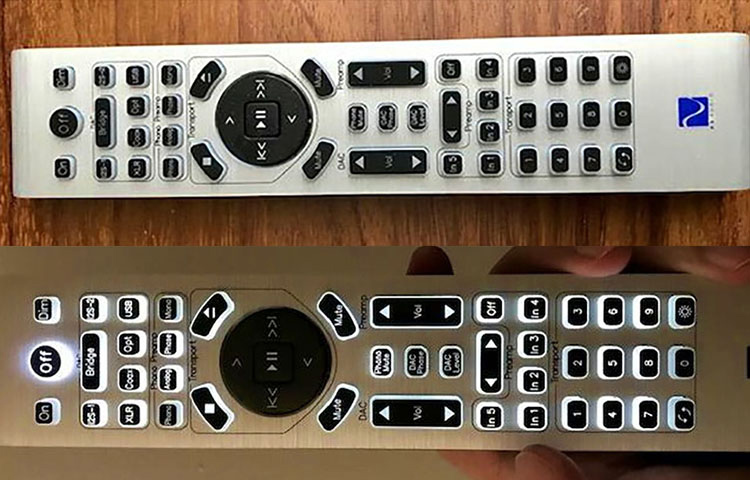
Some frustration then ensued. If I played an SACD (stereo) out to the DSD from my OPPO UDP-203, the OPPO down-sampled the DSD signal to 88kHz. Still hi-res, but not pure DSD. The I2S inputs on the DirectStream do not accept regular HDMI signals. The I2S bus separates clock and serial data signals, resulting in simpler receivers than those required for asynchronous communications systems that need to recover the clock from the data stream. Thus, you need a device that can put out I2S, and that is another expense or another product you must buy from PS Audio. After having reviewed a few McIntosh products, they too use a proprietary interface called MCT. I get it, keep it simple and pure, but why put the onus on the average music buff to find a way to get a DSD signal from point A to point B? Maybe the blame should fall on Sony. The master clock in the DirectStream helps reduce jitter from all inputs. In any case, streaming DSD (single and/or double rate) music from my Mac to the DirectsSream via USB was nothing short of astonishing! I am particularly enamored with the recordings from the Norwegian based 2L. I recommend going to their site and downloading as many free samples as you can. Find what you like and then purchase and download the albums. Blue Coast records offer free jazz samples, and in spite of OPPO’s withdrawal from audio world, they still offer free samples as well. Really, it’s a DSD world out there, but you have to look for it!
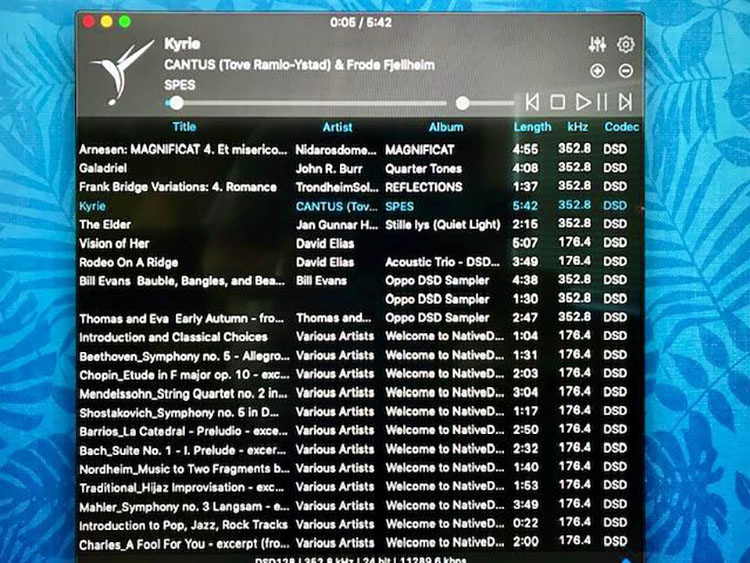
Fortunately, I have a few dozen DSD music files on my Mac that I could play to my heart’s content. I read somewhere that I might be able to rip DSD from my SACD collection with a software utility, but that is out of my range for this review. I also subscribed to Qobuz, so I have virtually unlimited hi-res music at my fingertips for this review, up to 24/192 resolution. On your smart device, you’ll have to download the Mcontrol App, to work as an interface between the DSD and your network. The Mcontrol App works well, but it does seem a bit clumsy and not in step with the quality of the DirectStream. To make things more interesting, I was able to listen to Snowmass for a few weeks, before upgrading to Windom, the latest firmware update for the FPGA.
I noticed a few differences between the two firmware packages. Windom sounds more open, more 3D-like with better staging and air between the musicians. Voices also seem a little more focused and forward in the mixes. In general, the music seems more organic, and more, for lack of better description, musical. My CD collection was sounding like sonic wallpaper…. it’s there, but not very emotionally engaging. Windom replaced its soul and life force by fleshing out the music into a more realistic 3D space and a more supportive low end. The improved bass gave the music more authority and muscle.
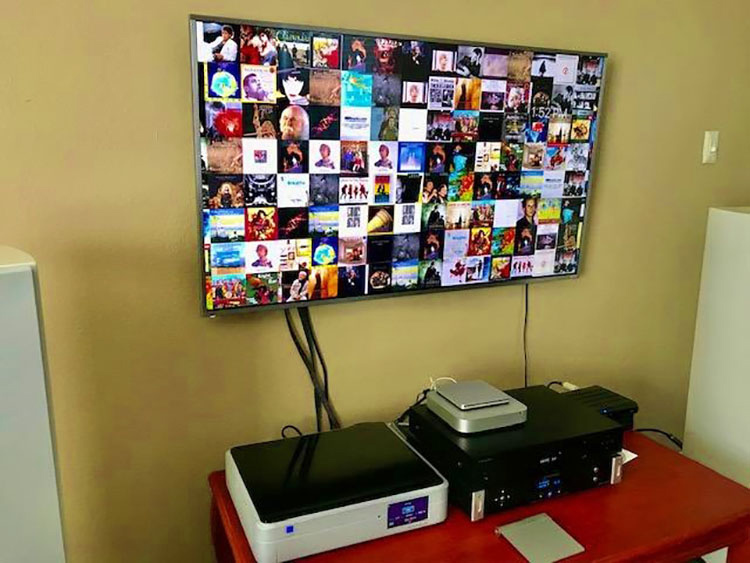
Some examples of music that best showcase my thoughts on PS Audio’s PerfectWave DirectStream DAC are:

Bear’s Den: Red Earth and Pouring Rain – This recording has a fat sound with a lush layering of vocals and acoustic instruments that harmonize in ways reminiscent of the Everly Brothers… only more hip and cool with a bit of dark undercurrent in the lyrics. The expansive sound was well conveyed by the DirectStream and despite the fat sound, it all had a sense of depth and space. This is great music to turn up and relax with on a Saturday while watching football with the TV sound turned off. Hey, I like to multi-task sometimes.
Diana Krall: The Girl in the Other Room – She has a great voice and it works with some of these off-the-beaten-track tunes (some written by her husband, Elvis Costello). The intimacy of her voice and small ensemble players is wonderful. You can hear her take in a breath on some songs and you are immediately struck by the close placement of the microphones and the tiny details they have captured. Everything just sounds alive, like being on stage with them when it was recorded. The DirectStream made it sound so perfectly natural, so you just relax, even though you are trying to listen critically. That is a quality you want to hear. Music should transport you from your daily grind and make you just enjoy the sound.
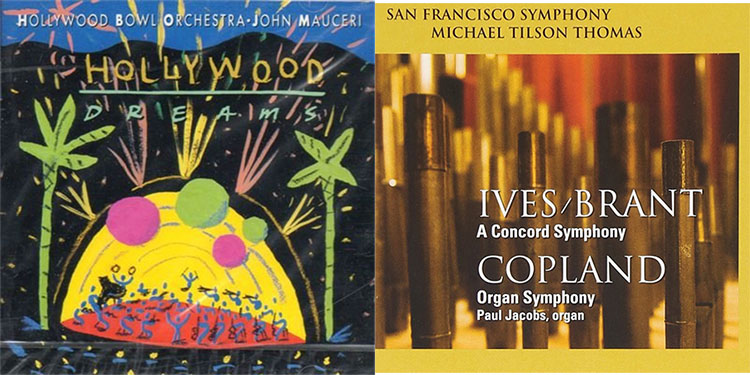
For orchestra, I chose The Hollywood Bowl Orchestra (Dir. John Mauceri): Hollywood Dreams. It features music from famous movies such as Dances with Wolves, E.T., Carousel, and my favorite, the suite from The Wizard of Oz. What I love about this recording is the fact that you can hear the venue they play in. It sounds like a large soundstage and you get just enough reverberation from the space that you can almost feel like you are there. Most orchestras are recorded in very large halls with lots of open space (and empty seats). This one sounds more intimate, and I like that. It features impeccable playing, and everyone likes the Wizard of Oz music, which is quite interesting in its arrangement… and fun, too. Though the space is close, you hear every detail while the instruments play against each other in left to right, front to back musical tag. The bass has depth, the brass is rich, and the strings sound natural and never strident. I’m struck with how very analog it sounds.
The San Francisco Symphony with Michael Tilson Thomas playing Ives and Copland – This SACD has an astonishingly good sound quality and the Copland Organ Symphony is made up of devilishly syncopated rhythms and heavy jazz influences. The organ is treated as part of the orchestra and not just as a solo instrument. The sense of depth, when the organ joins in, is impressive. I knew the DirectStream was special when it was able to place the orchestra in the fore and the organ behind and slightly above the stage. The strings shimmered, the brass had plenty of blatt, and the tympani and organ pedal notes placed the music on a firm foundation.

The PS AUDIO PERFECTWAVE DIRECTSTREAM DAC makes music sound more natural and analog than anything I’ve listened to before. With the promise of future firmware refinements, it will stay fresh for years. What other DAC can make that claim?
- Detailed, but not analytical sound
- Free FW updates that tweak the sound quality, plus, you can go back to prior versions if you like them better
- Solid construction and a pleasing aesthetic design
- Intuitive touchscreen with informative display
- Works as streamer and pre-amplifier
- Different color-scheme display choices
- Better app interface than Mcontrol
- An interface other than I2S
With my subscription to Qobuz, I have changed my music listening paradigm. I’ll keep my discs, but now I have a world of hi-res music in the palm of my hand. The PS Audio PerfectWave DirectStream DAC lets me hear more into my music and has me enjoying and exploring all different genres. Even my CD collection sounds refreshed. With the promise of more free firmware updates in the future, I feel confident that those who own PS Audio’s PerfectWave DirectStream DAC will be glad they invested in it. This is about as close to hearing that unicorn we call “analog sound”, and I don’t mean analog like the limited dynamics of vinyl. It just has a smooth, detailed, and rich sound that your ears will never tire of. It may not be perfect, but its design is unique, even amongst the other few DSD based DACs out there. Paul and Ted, thanks for pushing the envelope and trying to move the musical bar higher. I’m looking forward to the view from the next mountain top.


